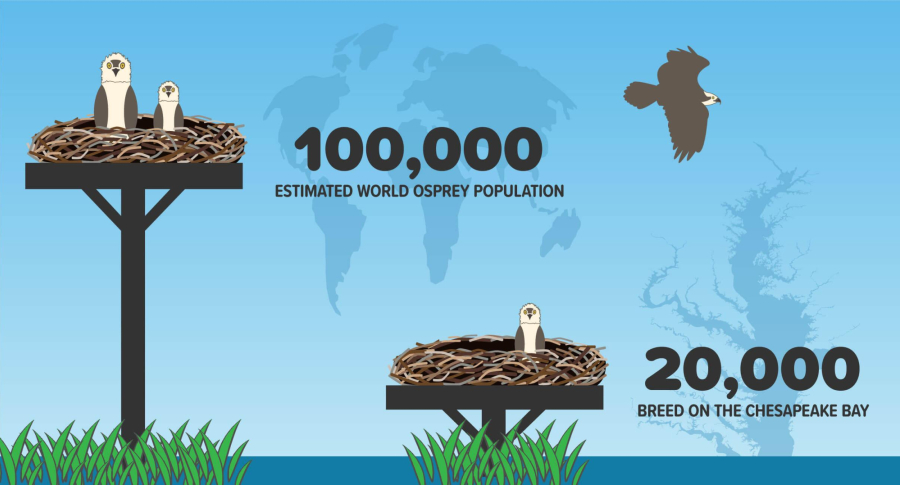Osprey
These raptors may be found on nearly every corner of the world, but the Chesapeake region is home to the largest concentration of nesting osprey.
Overview
Ospreys are one of the most iconic species in the Chesapeake Bay. While they’re found across the world, the largest concentration of the rapture exists right here in the Chesapeake region. They arrive in the Chesapeake Bay region in early March and remain here through spring and summer, when they migrate southward for the winter in mid-August.
How many ospreys are in the Chesapeake Bay?

Show image description
The infographic features two nest platforms that are being used by breeding pairs of ospreys. One platform is very tall, and its nest contains two ospreys. The second platform is short, and its nest contains one osprey. The tall platform represents the estimated world osprey population of 100,000. The short platform represents the estimated 20,000 ospreys that breed on the Chesapeake Bay.
Estimates from the Center for Conservation Biology place the Bay's current osprey population at eight to 10,000 breeding pairs, with the world population estimated at fewer than 100,000 birds. This is a significant increase from the 1970’s when it was estimated that there were as few as 1,450 breeding pairs. Research from the 1990’s showed an increase in reproduction among breeding pairs, with rates growing from less than 0.8 young produced per active pair in the 1960s to more than 1.2 young produced per active pair in the mid-1980s. Reproduction rates returned to less than one young produced per pair in the late 1980s.
What impacts ospreys?
In the Chesapeake Bay, ospreys are most impacted by habitat loss, access to fish and the release of toxic contaminants into the water. Ospreys live along the tidal portions of the Bay, where they make their nests and hunt for food. Development on shorelines can replace or disrupt this habitat, while low populations of fish can make it difficult for osprey to support their young. Additionally, toxic contaminants make it up the food chain and impact the health and reproduction of ospreys.
Ospreys breeding in the Bay
Historically, the Chesapeake Bay has supported the largest concentration of breeding ospreys in the world. Ospreys are typically monogamous and will mate for life. Breeding pairs have been known to return to the same nest site year after year. Females lay three eggs between mid-April and late May, which incubate for 38 to 42 days. Access to trees or man-made platforms to nest in is crucial for the survival of ospreys, as they need a place to safely keep their eggs from predators. Each summer, you can watch osprey eggs hatch through nesting cams from the Chesapeake Conservancy orChesapeake Bay Foundation.
The recovery of ospreys in the Chesapeake Bay
While the widespread use of toxic pesticides pushed populations of ospreys to an estimated low of 1,450 breeding pairs in the early 1970s, a 1972 ban on the pesticide DDT helped populations recover. By the mid-1990s, an estimated 3,500 breeding pairs were found on the Bay, and breeding was documented on almost half of the Bay's tidal tributaries. Today, an estimated eight to 10,000 breeding pairs live in the Bay.
Restoration efforts have included reintroduction programs, where wildlife biologists release osprey into areas with high quality habitat, as well as the creation of man-made nest sites to counter the loss of trees. Today, many osprey populations nest almost entirely on artificial nest sites, becoming an iconic site in the Chesapeake Bay.
What you can do
To protect osprey, consider using non-toxic pesticides or chemical-free cleaning products to curb the amount of toxic contaminants entering the water. You can also follow safe and legal disposal methods for paint, motor oil and other household chemicals, and keep pharmaceuticals out of waterways by returning unused medicine to a consumer drug return location.
